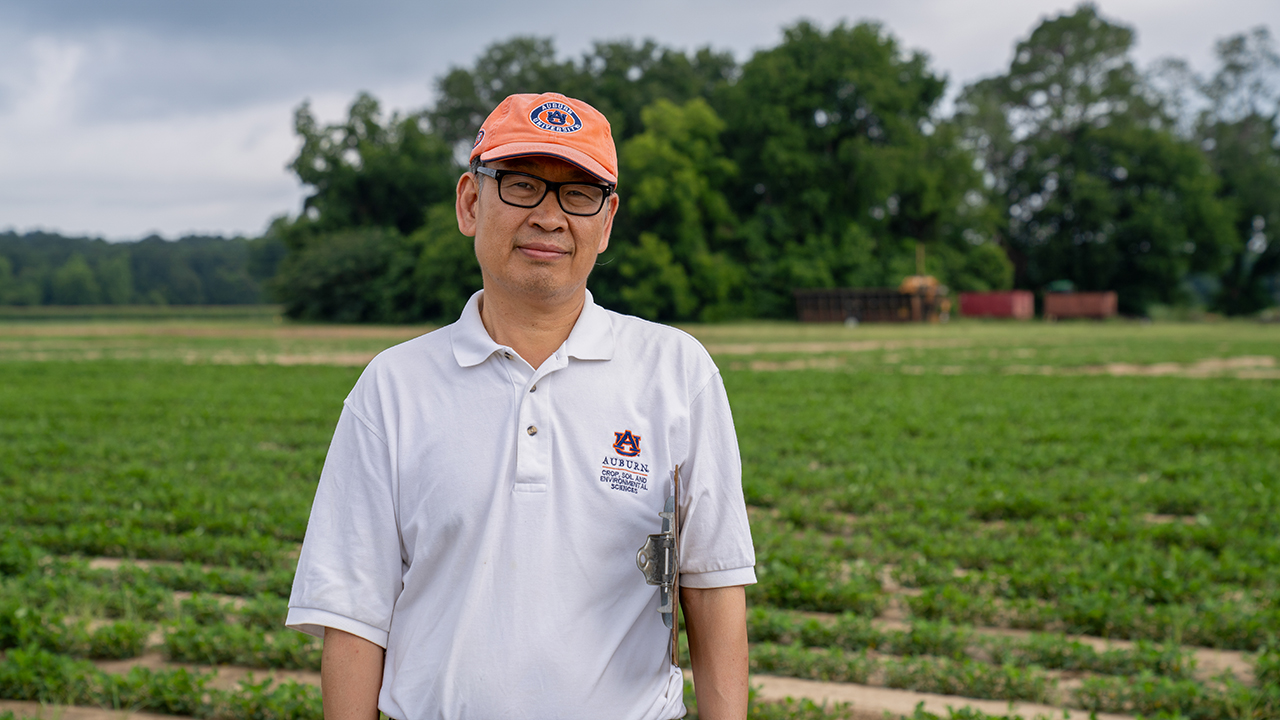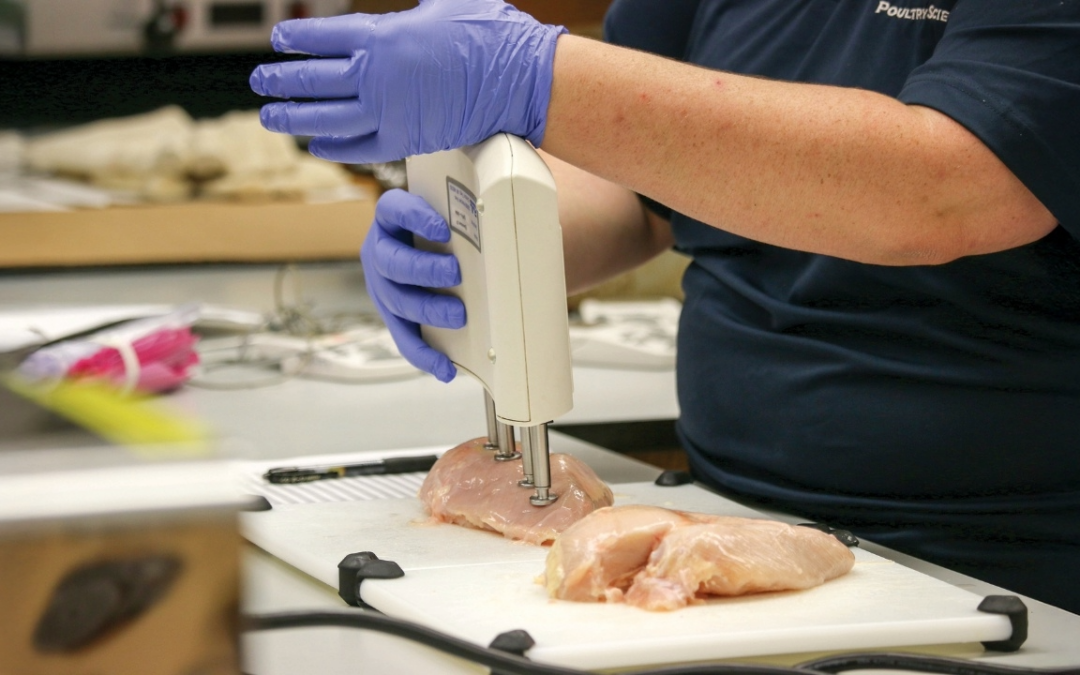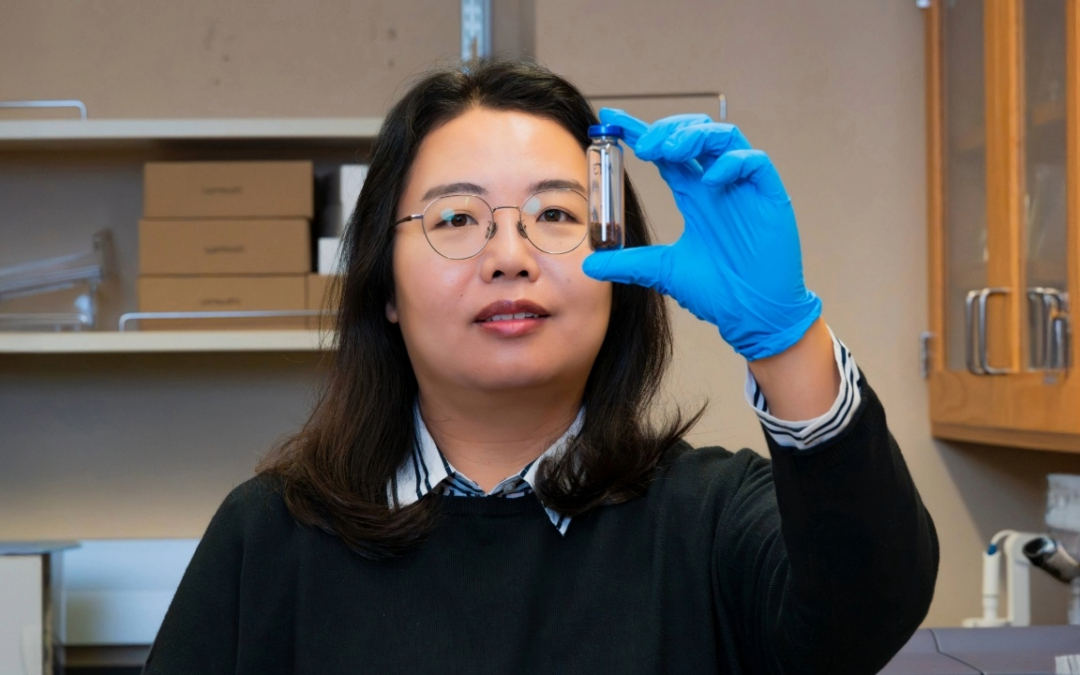Auburn University’s peanut breeding program is still in its infancy by most standards. It was begun in 2012, compared to similar programs at the University of Florida and University of Georgia that were begun in 1928 and 1938, respectively. And plant breeding, by its very nature, is a painstaking and lengthy endeavor.
But the Auburn program has made significant strides in a surprisingly short amount of time, with one of its varietal releases now commanding 40-50% of the peanut acreage in Alabama.
Charles Chen, who has led the program since its inception, was eager to accept the challenge of beginning such a program from scratch, having worked in peanut breeding at the USDA-ARS National Peanut Research Laboratory in Dawson, Georgia, since 2007.
“The Alabama Peanut Producers Association wanted the state to have its own peanut breeding program to address Alabama-specific production problems, so it worked with the College of Agriculture to establish one,” said Chen, who is also a professor in the Department of Crop, Soil & Environmental Sciences and a researcher with the Alabama Agricultural Experiment Station.
“We cooperate with the National Peanut Laboratory because I brought the germplasm I was working on at that location into our program here,” he said. “We continue to work with those breeding lines.”
In just a few short years, Chen’s program scored a hit with its first release—AU-NPL 17—a peanut variety that has become a favorite of producers in Alabama and the Florida Panhandle.
AU-NPL 17 is a “runner-type” variety, the most dominant peanut type grown in the U.S. and primarily used in the production of peanut butter. Alabama is the second largest peanut-producing state in the nation behind Georgia, with farmers planting 175,000 acres in 2023 with a value of $120 million. Acreage is expected to top 180,000 this year.
“It takes many years to propagate the seeds,” Chen said. “We started with an original release of 100 pounds of AU-NPL 17 breeder seed and sold approximately 6 million pounds of certified seed this past year. After growing the variety in farmers’ fields, we now have a clearer picture of how it performs. It has a high yield—which is the primary component—and is resistance to common peanut diseases such as leafspot, tomato spotted leaf virus (TSWV) and white mold.
“In variety trials, AU-NPL 17 is consistently among the top in disease resistance among commercial varieties, along with Georgia 12Y. It also performs well in irrigated or dryland conditions. In addition, it offers a prolonged window for harvesting, which is beneficial in the case of weather delays.”
AU-NPL 17 is also high-oleic, which means it contains a higher amount of oleic acid (more than 75%) compared to standard peanuts (about 45%). Oleic acid is a monounsaturated fatty acid, also known as a “good fat” that reduces the amount of LDL (bad cholesterol) while boosting the levels of HDL (good cholesterol). This trait also substantially improves the shelf life of peanuts and peanut products.
The peanut industry is now demanding a high-oleic peanut, with companies like Mars Chocolate committed to using 100-percent high-oleic peanuts in all its products.
While Auburn’s peanut breeding program remains the youngest of its kind in the nation, the release and subsequent stellar performance of AU-NPL 17 has created a solid foundation for its future.
“The No. 1 difficulty in starting a breeding program is the time commitment,” Chen said. “From day one until the variety is released, it takes at least 10 years to develop a variety, if you’re lucky. It requires great patience and consistent investments each year.
“It also takes a new breeder time to understand the crop. My Ph.D. training was in soybeans at the University of Illinois at Champaign-Urbana, so I switched to peanuts and had to learn specific traits of the plant and the inner workings of the peanut industry.”
The most desirable trait in any breeding program is yield because it most affects a producer’s bottom line, Chen said. Second is disease resistance and third is drought tolerance.
Not resting on the laurels of AU-NPL 17, Chen has several new peanut varieties in the pipeline, including AU22-37, which will be placed in the Uniform Peanut Performance Test this year in Alabama, Georgia and Florida.
“It is showing better yield potential than AU-NPL 17 and maturity is a little shorter at about 140 days,” he said. “The SMK or sound maturity kernel percentage is higher than with AU-NPL 17 at about 74 or 75%. Another line, AU22-42, is a sister line of 37. The seed size is smaller than 37, but the other traits are similar.
“These varieties must go through many different trials before they can be proven good enough for farmers’ fields. There’s a lot in the pipeline, but honestly, you’re never sure which line will perform well until it is grown in the field because interaction between genotype and the environment plays such a significant role in plant performance. That’s the big challenge for the breeder. You start in small 40-foot plots and hope it translates to many acres.”
By leveraging advancements in breeding techniques such as marker-assisted selection and genomic selection, breeders can make significant progress in a relatively short amount of time but only to a certain extent, since desirable traits such as high yield and drought tolerance are complex genetically, Chen said.
Auburn’s peanut breeding headquarters, he said, is at the Experiment Station Wiregrass Research & Extension Center in Headland in southeast Alabama.
“We are growing all our breeding lines there because of the environment, including soil type, disease prevalence and weather conditions,” he said. “I also have trials at the Brewton Agricultural Unit and at the E.V. Smith Agricultural Research Center in Shorter. Because of our cooperation with the National Peanut Laboratory, we also have a trial in Dawson, Georgia. In addition, we have a close relationship with the Alabama Crop Improvement Association in Headland where our Foundation seed is grown.”
Between Auburn’s breeding program and the ones in Georgia and Florida, there are more peanut planting options available today, and that’s a good thing for farmers, he said.
Paul Patterson, dean of the College of Agriculture and director of the Experiment Station, said Chen had brought extensive experience and success to Auburn’s peanut breeding program.
“The share of peanut acreage planted to AU-NPL 17 continues to grow,” Patterson said. “Peanuts are historically and economically important to Alabama agriculture. Research on peanut production has been a focus of the Alabama Agricultural Experiment Station for decades, particularly at the Wiregrass Research and Extension Center in the heart of peanut production.”
Chen’s breeding program also enables him to train the next generation of plant breeders who are needed by the agricultural industry to sustain progress in crop improvement, adds Steve Hague, head of the Department of Crop, Soil and Environmental Sciences.
“Also, by having a peanut breeding program at Auburn University, we can address peanut production problems that specifically affect Alabama growers,” Hague said. “Peanuts are an important rotation crop in Alabama, but they need to have high-quality genetics to be an economically viable planting option for growers.”
Chen also is working with other Auburn researchers on several nationally funded grant research projects, including ones that focus on identifying and developing drought tolerance in peanut plants
“We’re making great progress with drought tolerance, and that’s important because the majority of Alabama’s peanut acres are not irrigated,” he said. “We have discovered there are two types of drought-tolerant peanut varieties — water savers and water spenders. From a breeding standpoint, we can know which drought-tolerant type we are going to use in mate selection. It may be seven to eight years before we release a variety with this level of drought tolerance, but that remains a future focus of our breeding program.”





